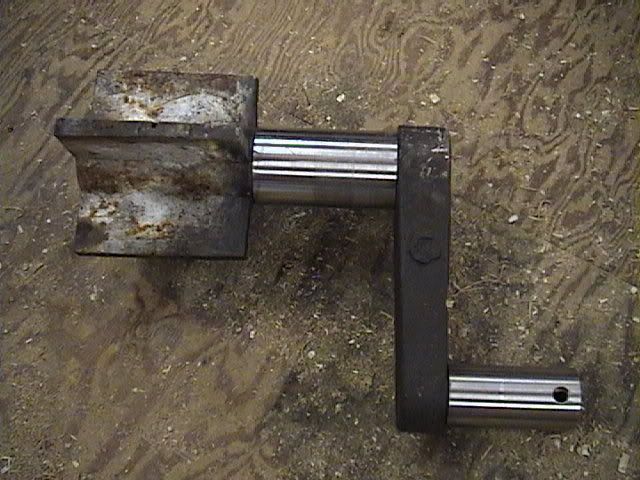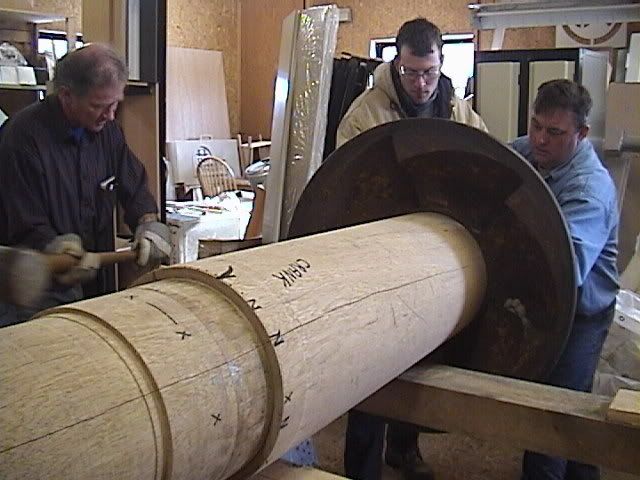|
 Re: historic hewing questionnaire
#24878
12/15/10 02:54 PM Re: historic hewing questionnaire
#24878
12/15/10 02:54 PM
|
Joined: Apr 2002
Posts: 895
daiku

Member
|

Member
Joined: Apr 2002
Posts: 895 |
Glad to see you've figured out all the ins and outs (ups and downs?) of posting pictures, Richard. Keep 'em coming. CB.
--
Clark Bremer
Minneapolis
Proud Member of the TFG
|
|
|
 Re: historic hewing questionnaire
#24880
12/16/10 02:52 AM Re: historic hewing questionnaire
#24880
12/16/10 02:52 AM
|
Joined: Mar 2002
Posts: 1,198
northern hewer
 OP
OP
Member
|
OP

Member
Joined: Mar 2002
Posts: 1,198 |
Hello everyone tonight
Hi CB nice to hear from you and the best in the new year
well things sort of slow down in the cold weather here and I thought that I would sharpen up my posting skills. I must say I surprised myself that I remembered the pass words, but proceedures was something else, I had to refer back to instructions from one of you guys a while back, and it all came together nicely--I hope you enjoy them as much as I enjoy posting for you all.
I am proud to be associated with the TFG group and be able to present items of interest from my past.
One area of historical interest that I will never escape from is the mulley mill and its wonderful but complicated equipment for sawing lumber with a single vertical blade
Having the opportunity to be in charge of the maintenance as well as the operation was a one in a million roll of the dice, and I intend to pass on tidbits of information to those that want to listen.
I often sat in the early morning sunlight streaming through the interior of the mill reflecting on those that must have went before me, and felt their presence and was able to overcome what seemed like unsurmountable tasks that rose from time to time with its delicate technicalities.
I believe that one of the greatest challenges I ever had was to put the mill together in running order after having dismantled it for reconstruction and repair, knowing full well that no help was available if it was required.
see you tomorrow night
NH
|
|
|
 Re: historic hewing questionnaire
#24882
12/17/10 01:29 AM Re: historic hewing questionnaire
#24882
12/17/10 01:29 AM
|
Joined: Mar 2002
Posts: 1,198
northern hewer
 OP
OP
Member
|
OP

Member
Joined: Mar 2002
Posts: 1,198 |
 Hi everyone tonight Here is a good view of the offset crank and its wings upon its removal from the old wooden shaft. It is at this point that you get a funny sick feeling in your gut because you know full well that in the next few months you will need to have a fully operational new wooden axle complete with the crank installed, placed in a new wooden pressure box of exactly the right width, and I mean with the following criteria: The pressure box (a view will be coming in the next installment or so) has to be so designed that any swelling of the water acting on the wooden surfaces will not create problems, and to that end you have to be sure to allow for that expansion, but not too much either to allow for excessive seepage along the edges of the cast iron collars, or in the reverse not allow the shaft to revolve. There is no text books available to my knowledge that contains such information, you are on your own, and it is a lonely ride let me tell you. There could be someone out there with that experience but I was not able to locate them for any assistance. There are quite a few vertical blade mills sprinkled over the country but I dare to say that many of these mills are not operational, or maybe just coasting along with the equipment as it is, or not coasting at all. Some of the mills that I have visited have cast iron pressure boxes from what I can make out these types were running side by side in the same era, but were not available over all the primitive, or newly opened up areas of settlement hope you enjoy this trip down memory lane NH
|
|
|
 Re: historic hewing questionnaire
#24888
12/19/10 02:59 AM Re: historic hewing questionnaire
#24888
12/19/10 02:59 AM
|
Joined: Mar 2002
Posts: 1,198
northern hewer
 OP
OP
Member
|
OP

Member
Joined: Mar 2002
Posts: 1,198 |
 Hello everyone tonight As I promised here is a view of the newly reconstructed turbine box being readied for the new wooden oak shaft. The placement of this box was a very delicate job because it had to be move about 6" to compensate for the movement sideways of the mill structure over a period of roughly 40 years, Many would say that this is not very much of a problem, but for starters this pretty well moved all the benchmarks that had been established during the dismantling process, and meant that all new ones had to be established Try it! enjoy NH
|
|
|
 Re: historic hewing questionnaire
#24889
12/19/10 05:40 AM Re: historic hewing questionnaire
#24889
12/19/10 05:40 AM
|
Joined: Feb 2006
Posts: 718
Dave Shepard

Member
|

Member
Joined: Feb 2006
Posts: 718 |
Looks like a really fun project. If it were easy, it wouldn't be much fun, in my opinion. Probably only a handful of people doing what you are doing. Could you pre-soak the turbine box and then machine it to the exact dimension?
Member, Timber Framers Guild
|
|
|
 Re: historic hewing questionnaire
#24892
12/20/10 03:20 AM Re: historic hewing questionnaire
#24892
12/20/10 03:20 AM
|
Joined: Mar 2002
Posts: 1,198
northern hewer
 OP
OP
Member
|
OP

Member
Joined: Mar 2002
Posts: 1,198 |
Hello everyone tonight
Hi Dave,thanks for coming on board and the comments:
Well for starters Dave the White oak I used to fabricate the pressure box was milled from green logs, I did this on purpose so that the swelling of the box would not be excessive, when it eventually was exposed to water.
The problem was it was hard to determine just how much the timber was drying during the time from the milling process, the fabrication process and then of course the installation process, and most of these processes was in a heated environment
I realize that across the grain not much movement would take place especially with oak, but then there would be some, and the box is 36inches across solid wood, you can see what I mean.
On both sides of the pressure box run cast iron collars approx 36 inches in diameter, and these collars are on turned surfaces shouldered to bottom out at exactly the right spot and have cups molded in them in such a manner that the escaping water forces the shaft to spin in the opposite direction
You can see why the expansion of the box could be a real problem because these collars have a very small clearance and must run true so that they do not bind against the side of the pressure box
One of the problems associated with this type of power source is as the water passes through it also brings with it many fine particles and anything the right size can jam the wheel and stop the whole mill
I want to say this whole process was very interesting for me and my team, but in the end it ran like a top and is still running perfectly after approx 12 years now.
Hope you enjoy
NH
|
|
|
 Re: historic hewing questionnaire
#24894
12/20/10 04:39 AM Re: historic hewing questionnaire
#24894
12/20/10 04:39 AM
|
Joined: Feb 2006
Posts: 718
Dave Shepard

Member
|

Member
Joined: Feb 2006
Posts: 718 |
Thanks for sharing! I'd like to work on a mill or two someday. Water, wind, whatever. There is a chapter in "A Village Carpenter" by Walter Rose, on windmills and their care. Very interesting reading.
Member, Timber Framers Guild
|
|
|
 Re: historic hewing questionnaire
#24930
12/23/10 01:00 AM Re: historic hewing questionnaire
#24930
12/23/10 01:00 AM
|
Joined: Mar 2002
Posts: 1,198
northern hewer
 OP
OP
Member
|
OP

Member
Joined: Mar 2002
Posts: 1,198 |
 Hi everyone tonight Here is a goodview of the turbine shaft still in the lathe You will notice turned seatings in the foreground the closest turned seating is the identical diameter of the outside of the wings, and slots will be cut into this turned seating for the wings to slide back into, and then be held in place with babbet and the wrought iron rings, a view of this I posted first. Alittle further you will notice another turned surface this is for the 36" cast iron rings that have cups casted around its surface. You will notice that this turned surface ends abruptly and it is this detail that is extremely important because if it is not correct the rings would bind on the side of the pressure box or they could bottom out too far from the box if the shouldering ended too soon Keep in mind that these surfaces are tapered and again if the tapering is too tight on the interior of cast iron surfaces it could crack the casting when the wood expands as exposure to water eventually takes place there is alot of ifs here-- -if the wood turning is too tight failure of the casting takes place -if the woodturning is too loose then the cast iron collars will spin around and destroy the axle getting it just right is quite a feat, it was always in the back of my mind that should one of the cast collars crack, to have it replaced would cost thousands of dollars because a new pattern would have to be made by a pattern maker and then casted to allow for shrinkage in the casting process. NH
Last edited by northern hewer; 12/23/10 01:04 AM.
|
|
|
 Re: historic hewing questionnaire
#24931
12/23/10 01:22 AM Re: historic hewing questionnaire
#24931
12/23/10 01:22 AM
|
Joined: Feb 2006
Posts: 718
Dave Shepard

Member
|

Member
Joined: Feb 2006
Posts: 718 |
Fortunately they make tape measures that account for the shrink. We've had some stuff cast at an Amish foundry in PA that does very high quality work. But, I'd probably be worried about breaking something too.
Last edited by Dave Shepard; 12/23/10 01:23 AM.
Member, Timber Framers Guild
|
|
|
 Re: historic hewing questionnaire
#24948
12/26/10 05:54 PM Re: historic hewing questionnaire
#24948
12/26/10 05:54 PM
|
Joined: Mar 2002
Posts: 1,198
northern hewer
 OP
OP
Member
|
OP

Member
Joined: Mar 2002
Posts: 1,198 |
Hello everyone today:
Merry Christmas to all my visitors to this thread
I invite any questions about the above topic before I move on to another
NH
|
|
|
|
|